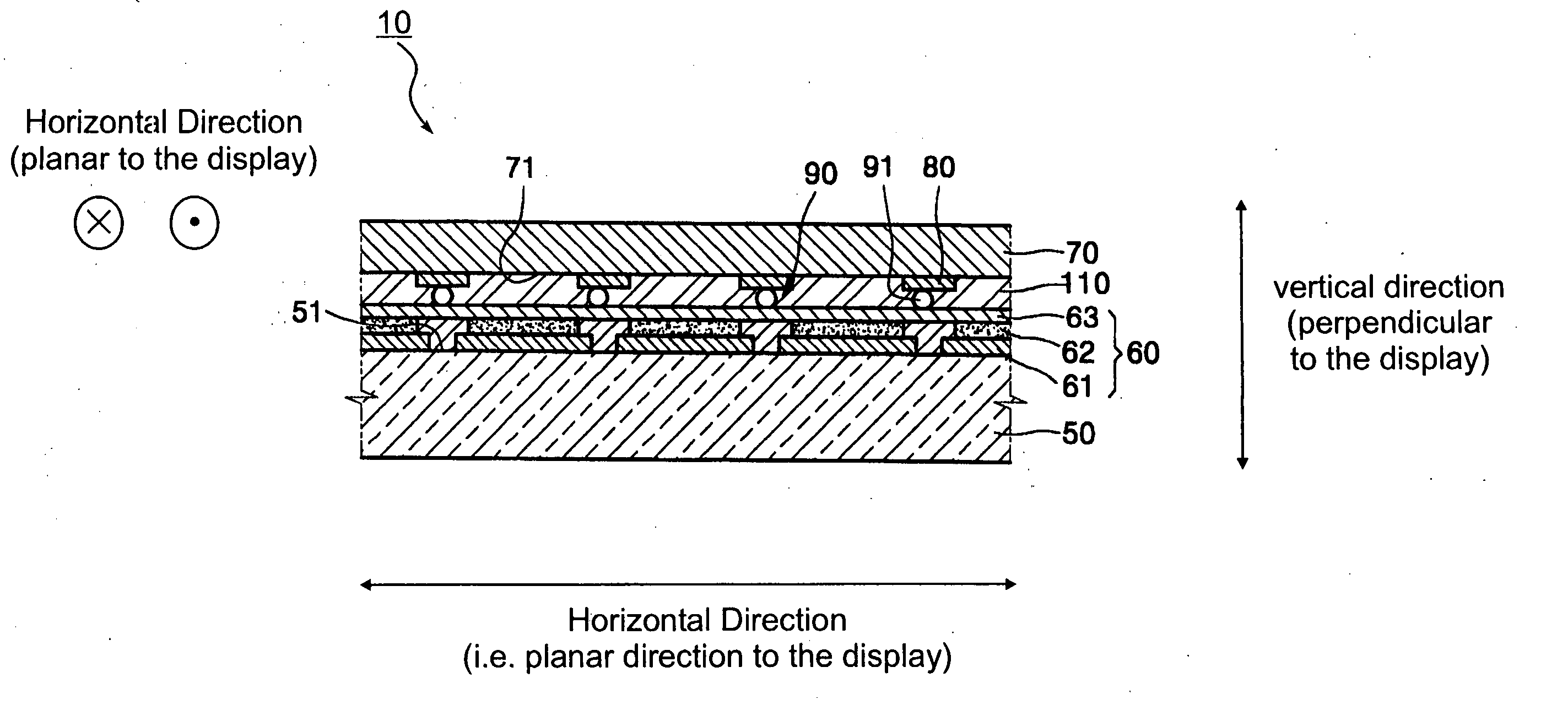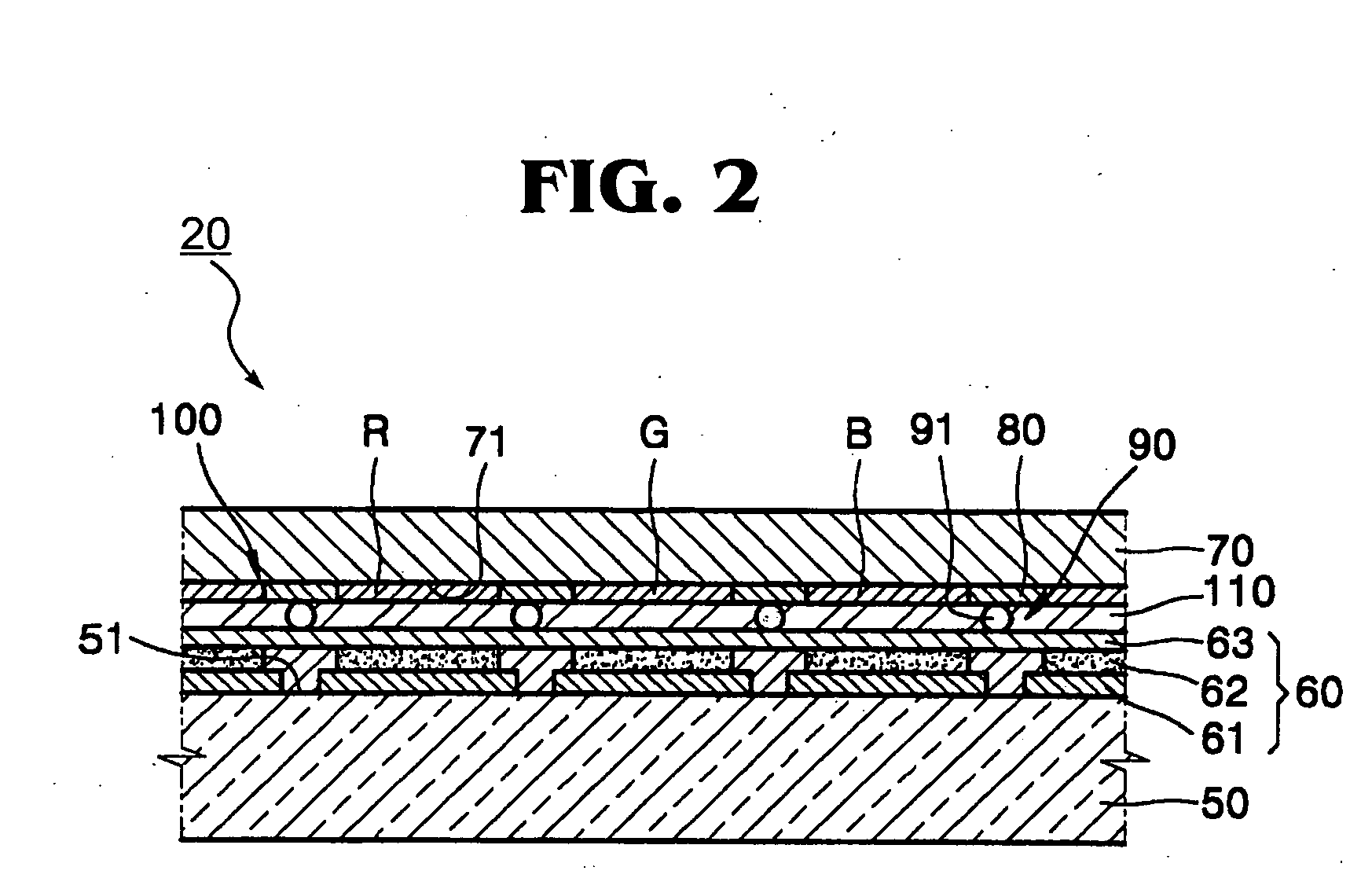Electrical conductors in an electroluminescent display device
a technology of electroluminescent display device and electrical conductor, which is applied in the direction of electroluminescent light source, electric lighting source, solid-state device, etc., can solve the problems of increasing the difficulty of using ito for an electrode, and affecting the operation of the device. , to achieve the effect of large screen siz
- Summary
- Abstract
- Description
- Claims
- Application Information
AI Technical Summary
Benefits of technology
Problems solved by technology
Method used
Image
Examples
first embodiment
[0037] Turning now to the figures, FIG. 1 illustrates an electroluminescent display device 10 according to the present invention. Display device 10 is a passive device with a front emitting structure and is made up of a rear substrate 50 and a front substrate 70 that are coupled with each other. On an upper surface 51 of the rear substrate 50, a first electrode layer 61, a light-emitting layer 62, and a second electrode layer 63 are orderly formed. The first electrode layer 61, the light-emitting layer 62, and the second electrode layer 63 constitute a light-emitting unit 60. On a lower surface 71 of the front substrate 70, a conductive black matrix layer 80 is formed in a predetermined pattern to face the second electrode layer 63. The term, “predetermined pattern” as used herein indicates a pattern designed for inhibiting the passage of as little light as possible emitted from the light-emitting layer 62 toward the front substrate 70. The term “predetermined pattern” also infers t...
third embodiment
[0046] Referring to FIG. 3, the conductive protrusions 92 are formed on the black matrix layer 80 that is formed on the lower surface 71 of the front substrate 70 corresponding to regions between pixels of the light-emitting unit 60. The protrusions 92 may be made of conductive particles that are adhered to the black matrix layer 80 by a conductive paste. Color filter layers R, G, and B may be formed on the remaining lower surface 71 of the front substrate 70, on the same level as the patterned black matrix layer 80 between patterned portions of the black matrix layer 80. Preferably, a transparent and non-conducting filler 110 is interposed between each of the R, G and B color filter layers and the light-emitting unit 60. Non-conductive filler 110 is also disposed between adjacent conductive protrusions 92 in this third embodiment of the present invention.
[0047] An electroluminescent display device 200 according to a fourth embodiment of the present invention will now be described w...
fourth embodiment
[0049] On a lower surface 271 of the front substrate 202, a black matrix layer 230 is formed. A plurality of connecting members such as conductive spacers 240 are interposed between the black matrix layer 230 and the transparent second electrode layer 211 to electrically connect black matrix layer 230 to each second electrode layer 211. Since only the second electrode layer 211 and not the black matrix layer 230 is made of a relatively highly resistive transparent conductive material, the voltage drop between the power supply or voltage source and each second electrode layer 211 in a display is low. Also, the potential at each second electrode layer 211 across the entire display is more uniform because there is little voltage drop across the black matrix layer 230. As in the first three embodiments, the fourth embodiment uses black matrix layer 230 and conductive spacers240 to deliver power and voltage to the transparent second electrode layer 211 instead of using only transparent c...
PUM
 Login to View More
Login to View More Abstract
Description
Claims
Application Information
 Login to View More
Login to View More - R&D
- Intellectual Property
- Life Sciences
- Materials
- Tech Scout
- Unparalleled Data Quality
- Higher Quality Content
- 60% Fewer Hallucinations
Browse by: Latest US Patents, China's latest patents, Technical Efficacy Thesaurus, Application Domain, Technology Topic, Popular Technical Reports.
© 2025 PatSnap. All rights reserved.Legal|Privacy policy|Modern Slavery Act Transparency Statement|Sitemap|About US| Contact US: help@patsnap.com



